Table of contents
Let’s be real — everyone wants to feel appreciated at work. A simple “thank you” can go a long way, but when recognition is thoughtful and consistent, it can completely transform a workplace. It boosts morale, strengthens teams, and keeps people motivated to do their best. In fact, Achievers Workforce Institute (AWI) data shows, 91% of employees who are meaningfully recognized at least monthly are very engaged at work, proving that frequent, heartfelt appreciation drives real results.
But here’s the thing: not all recognition is created equal. A generic shoutout or a one-size-fits-all reward won’t have the same impact as something personal and meaningful. That’s why we’ve pulled together some of the best recognition and appreciation ideas to help you celebrate your team in ways that truly matter.
Whether you’re looking for quick wins or long-term strategies, we’ve got you covered. Let’s dive in!
40 employee recognition and appreciation ideas
Organizations should make recognition personal and meaningful for their employees. To help, here are 40 recognition ideas, organized into key categories to show your team just how much you appreciate their hard work.
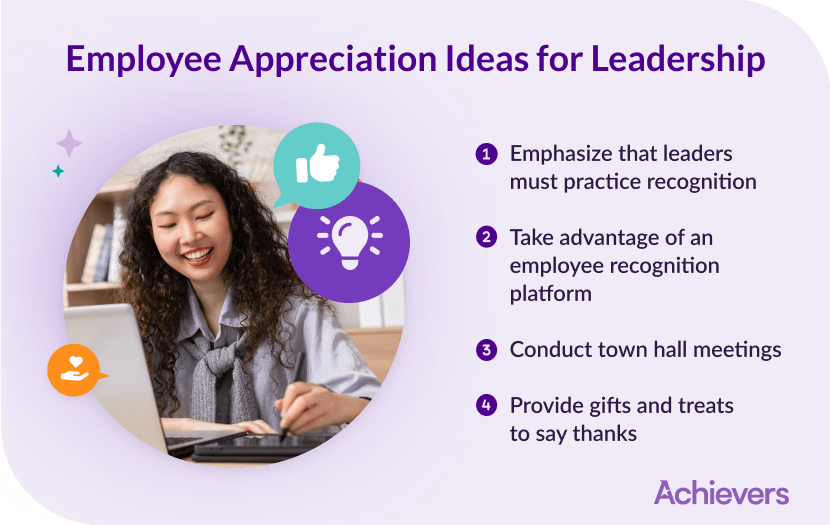
Employee appreciation ideas for leadership
Employee appreciation starts at the top. When leaders actively recognize and reward employees, it sets the tone for a culture of appreciation. Thoughtful gestures from leadership not only boost morale but also inspire teams to stay engaged and motivated. From leveraging recognition platforms to hosting town halls, here are impactful ways leaders can show appreciation and strengthen workplace culture:
1. Emphasize that leaders must practice recognition
Leaders set the tone for company culture. When they actively recognize employees — whether through a simple thank-you, public praise, or personalized messages—it fosters a culture of appreciation. Recognition should be frequent, specific, and aligned with company values to have a lasting impact. Leaders who regularly acknowledge their teams help boost morale, engagement, and productivity.
2. Take advantage of an employee recognition platform
A dedicated recognition platform makes it easy for leaders to acknowledge employee contributions in a meaningful way. Platforms like Achievers allow managers to send real-time recognition, reward employees with points, and celebrate achievements publicly. These tools streamline recognition efforts, ensuring that appreciation becomes an integral part of workplace culture.
3. Conduct town hall meetings
Regular town halls provide a forum for leadership to celebrate team successes, recognize standout employees, and reinforce company values. These meetings offer a transparent way to share updates while giving leaders the opportunity to personally acknowledge contributions. A simple shout-out from an executive can leave a lasting impression and motivate employees.
4. Provide gifts and treats to say thanks
Small tokens of appreciation, such as company-branded swag, gift cards, or personalized treats, can make employees feel valued. Leadership can surprise teams with breakfast, handwritten thank-you notes, or personalized gifts that reflect an employee’s interests. These gestures, though small, show employees that their hard work is recognized and appreciated.
5. Write handwritten thank-you notes
A handwritten note from a leader can be more impactful than an email or public recognition. It shows genuine effort and appreciation, making employees feel valued on a personal level. Whether it’s recognizing a job well done on a project or simply expressing gratitude for hard work, a thoughtful note can boost morale.
6. Offer leadership-led lunch outings with employees
Taking employees out for lunch provides a relaxed setting for leaders to connect with their teams, discuss career growth, and recognize contributions. These outings help bridge the gap between leadership and employees, fostering stronger relationships and reinforcing the company’s commitment to appreciation.
7. Implement a leadership recognition award program
Create an award program where leaders recognize employees who go above and beyond. Awards can be given monthly or quarterly, focusing on employees who exemplify company values, teamwork, or innovation. This formal recognition reinforces the importance of appreciation at all levels.
8. Feature employees in company-wide communications
Leaders can highlight employees in company newsletters, emails, or intranet updates. Featuring an “Employee of the Month” or sharing success stories ensures that recognition is visible to the entire organization. This public appreciation helps employees feel seen and valued.
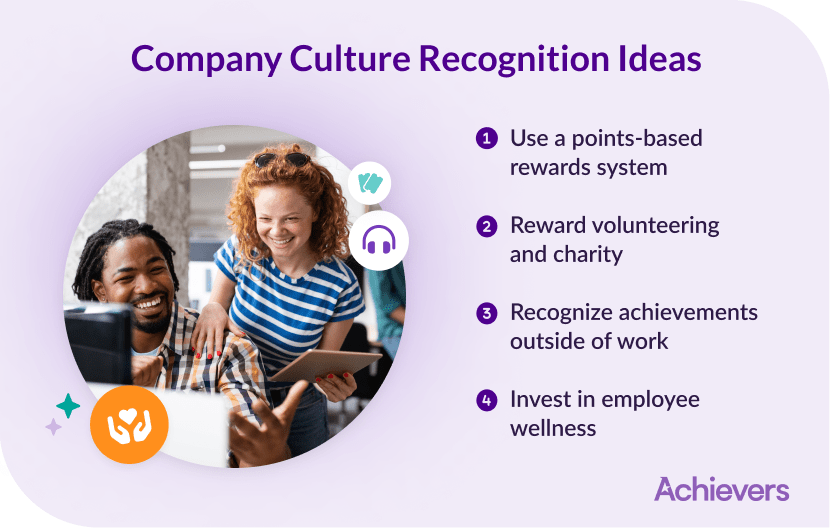
Company culture recognition ideas
A strong company culture thrives on recognition. When appreciation is woven into daily interactions, employees feel more connected, motivated, and engaged. From rewarding volunteer efforts to investing in wellness, here are impactful ways to foster a culture of recognition and appreciation in your organization:
9. Use a points-based rewards system
A structured, points-based rewards system encourages ongoing recognition. Employees earn points for achievements, which they can redeem for rewards like gift cards, experiences, or company perks. This system makes recognition consistent and meaningful.
10. Reward volunteering and charity
Encourage employees to give back by recognizing and rewarding their volunteer efforts. Offer paid volunteer days, match charitable donations, or spotlight employees who contribute to their communities. This fosters a culture of social responsibility and engagement.
11. Recognize achievements outside of work
Employees are more than their job titles. Recognizing personal achievements — whether completing a marathon, earning a degree, or volunteering — demonstrates that the company values employees as individuals. Consider shout-outs in meetings, newsletters, or internal social platforms.
12. Invest in employee wellness
Recognition isn’t just about praise — it’s also about support. Investing in wellness initiatives like fitness stipends, mental health resources, or wellness challenges shows employees that their well-being matters. Recognizing participation in wellness programs further reinforces this commitment.
13. Celebrate cultural and heritage events
Create an inclusive workplace by recognizing cultural and heritage celebrations. Organizing themed lunches, educational sessions, or employee spotlights helps promote diversity and belonging while celebrating employees’ backgrounds.
14. Create a peer-nominated “culture champion” award
Allow employees to nominate colleagues who embody company culture. This recognition program ensures that culture-driven behaviors are celebrated and reinforced across the organization. Winners can receive a prize, additional perks, or a feature in company communications.
15. Organize surprise appreciation days
Plan spontaneous appreciation events, such as a surprise breakfast, half-day Fridays, or fun activities. These unexpected gestures boost morale and demonstrate that the company values its employees’ hard work.
16. Highlight employee contributions in company newsletters
Dedicate a section in company newsletters to employee spotlights, achievements, and work anniversaries. Sharing personal and professional milestones creates a stronger sense of connection and appreciation.
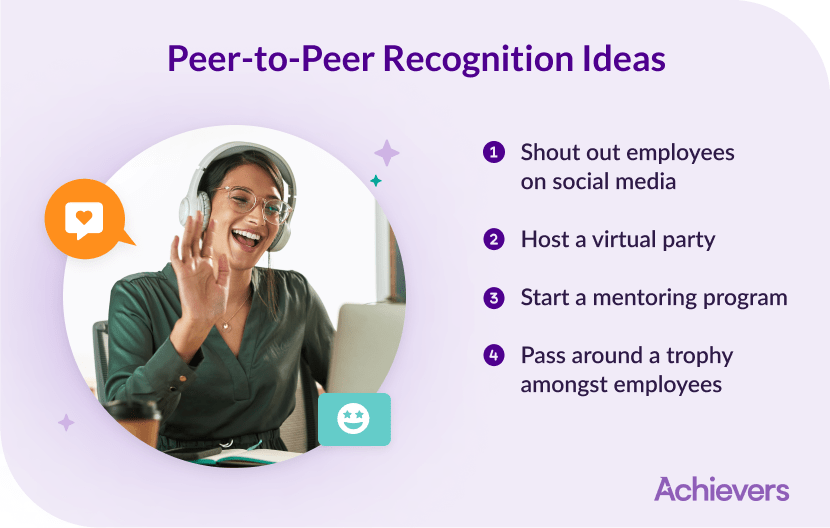
Ideas for peer-to-peer recognition
Recognition isn’t just a top-down effort — it thrives among peers. Encouraging employees to celebrate each other’s achievements fosters connection, collaboration, and a positive workplace culture. From social media shoutouts to mentoring programs, here are creative ways to make peer-to-peer recognition a core part of your organization:
17. Shout out employees on social media
Encourage employees to celebrate their peers by sharing recognition posts on social media or internal communication platforms. Public appreciation fosters a culture of support and gratitude.
18. Host a virtual party
Organize a virtual celebration where employees can recognize each other in a fun, interactive setting. Games, prizes, and shout-outs make these events engaging.
19. Start a mentoring program
Encourage employees to recognize and support each other’s growth through a mentorship initiative. Mentors and mentees can be acknowledged for their contributions.
20. Pass around a trophy amongst employees
Create a fun tradition where a trophy or symbolic item is passed between employees to recognize outstanding contributions. This keeps appreciation interactive and engaging.
21. Set up a kudos board
Create a physical or digital board where employees can post messages of appreciation for their peers. This provides a continuous stream of recognition.
22. Implement a digital “high-five” program
Use a recognition platform that allows employees to send digital “high-fives” or badges for achievements, making peer-to-peer recognition effortless.
23. Organize a peer-recognition challenge
Set up a challenge where employees earn points for recognizing others, with incentives for participation. This keeps recognition fun and rewarding.
24. Launch an employee-led appreciation committee
Form a committee dedicated to promoting peer recognition, organizing events, and ensuring appreciation remains a key part of the company culture.
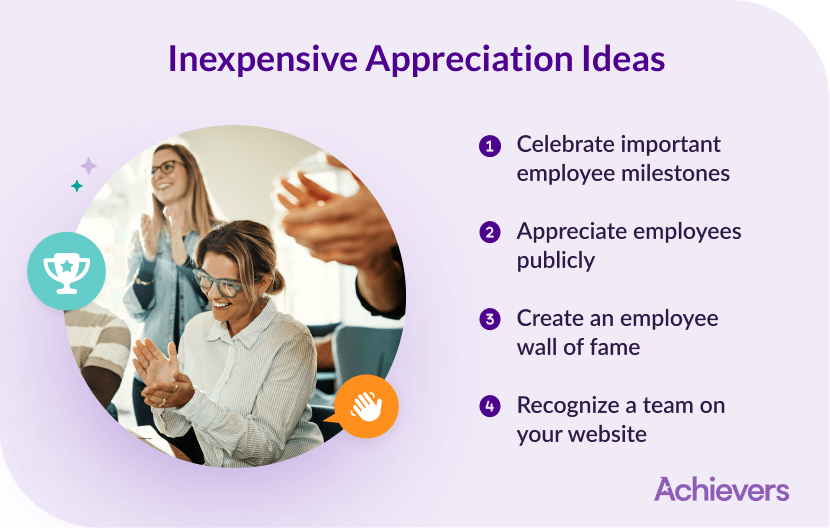
Inexpensive appreciation ideas
Showing appreciation doesn’t have to break the budget. Small, thoughtful gestures can have a big impact on morale and employee engagement. From public recognition to flexible work perks, here are cost-effective ways to celebrate employees and make them feel valued:
25. Celebrate important employee milestones
Recognizing birthdays, work anniversaries, and major life events (like weddings or new babies) makes employees feel valued beyond their work contributions. A simple email, a card signed by the team, or a small office celebration can go a long way in making employees feel special.
26. Appreciate employees publicly
Public recognition — whether in a company-wide meeting, a newsletter, or a Slack channel — boosts morale and highlights employees’ hard work. Even a verbal shout-out from leadership can reinforce appreciation and motivate employees to continue performing at their best.
27. Create an employee wall of fame
Dedicate a physical or digital space to highlight employee achievements. Featuring photos, stories, or “employee of the month” spotlights provides visible, ongoing appreciation that employees can take pride in.
28. Recognize a team on your website
Showcasing standout teams or employees on the company website demonstrates their value to the organization. This could be a monthly spotlight article, a rotating feature on the homepage, or a dedicated recognition section in the careers page to showcase the company culture.
29. Offer flexible work arrangements as a reward
Letting employees choose their schedule for a day, work remotely, or start late as a reward costs nothing but is highly valued. Flexibility shows trust and can be a powerful motivator while helping employees maintain work-life balance.
30. Give a personalized thank-you message from leadership
A heartfelt email, voicemail, or video message from a senior leader can make employees feel recognized on a deeper level. Personalizing the message with specific details about their contributions makes it more meaningful.
31. Host a casual “coffee with the CEO” event
Giving employees direct access to leadership in an informal setting fosters engagement and appreciation. A small group coffee chat allows employees to share insights, ask questions, and receive direct recognition from executives.
32.Create a rotating employee spotlight feature in newsletters
Dedicate a section in your internal newsletter or intranet to highlight employee accomplishments, personal achievements, and fun facts. This inexpensive initiative builds camaraderie and ensures employees feel seen and appreciated.
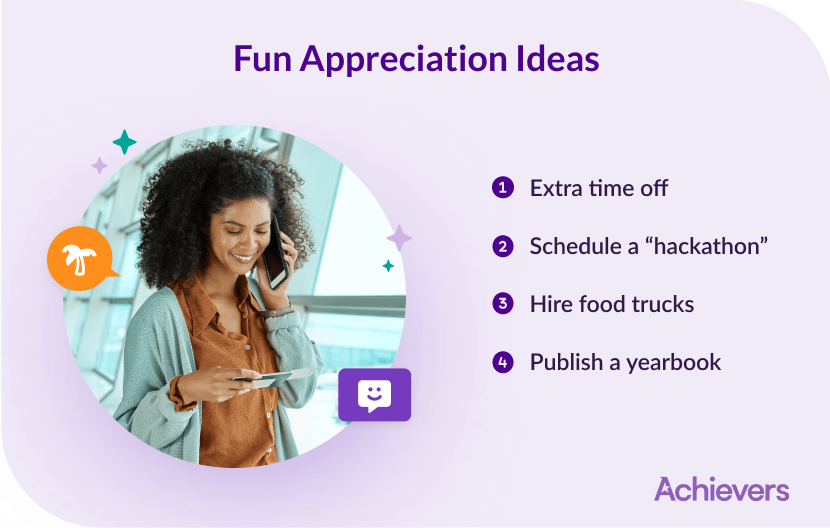
Fun appreciation ideas
Employee recognition should be exciting and memorable. Fun appreciation ideas create a positive, engaging workplace where employees feel valued and motivated. From extra time off to company-wide hackathons, here are creative ways to make recognition both enjoyable and meaningful:
33. Extra time off
Granting employees an extra day off or an early dismissal as a surprise reward can significantly boost morale. It’s a simple yet effective way to show appreciation and encourage work-life balance.
34. Schedule a “hackathon”
Organize a company-wide hackathon or innovation challenge where employees collaborate on exciting projects outside of their daily tasks. Offer prizes for creativity and execution to make it even more rewarding.
35. Hire food trucks
Bringing in food trucks for a company lunch break is a fun way to show appreciation. Employees get to enjoy a variety of delicious meals while taking a well-deserved break.
36. Publish a yearbook
Create a company yearbook featuring employee highlights, achievements, and fun moments from the past year. This is a unique way to celebrate workplace culture and recognize contributions.
37. Organize themed dress-up days
Plan dress-up days, such as “Retro Day” or “Favorite Sports Team Day,” to add a fun twist to the workweek. Encourage participation with prizes for the best outfits.
38. Host a company-wide game day or trivia challenge
Set up a game day with board games, trivia contests, or team challenges. Friendly competition boosts engagement and brings employees together in a relaxed setting.
39. Offer surprise snack breaks or happy hours
Surprise teams with mid-afternoon snack deliveries or an end-of-week happy hour. It’s a simple yet effective way to boost energy and morale.
40. Arrange mystery gift exchanges during holidays
Set up a “Secret Santa” or other themed gift exchange to create a fun and engaging recognition activity during the holiday season.
Jump-start your recognition program
Employee recognition and appreciation don’t have to be costly or complicated — what matters most is consistency and authenticity. By leveraging leadership-driven initiatives, fostering a culture of appreciation, incorporating fun and peer-to-peer recognition, and embracing budget-friendly ideas, companies can create a workplace where employees feel valued and motivated.
Whether it’s a simple thank-you note, public recognition, or a structured rewards program, these gestures contribute to higher engagement, stronger retention, and a more positive work environment. When recognition becomes a core part of company culture, employees feel empowered to do their best work — driving both individual and organizational success.
Find out what makes an online employee recognition platform effective
Get the 2024 Recognition Report

